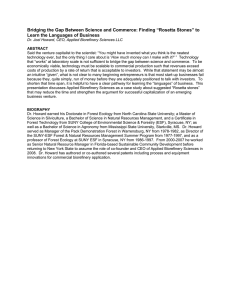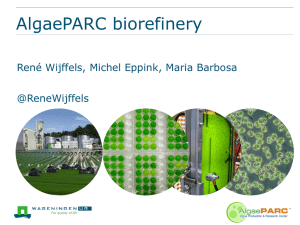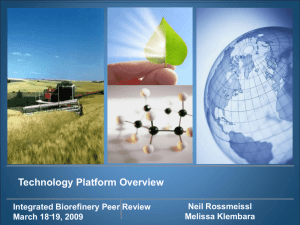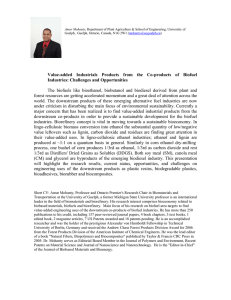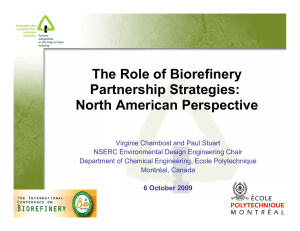Guided Tour: Implementing the Forest Biorefinery at a Pulp and Paper Mill
advertisement
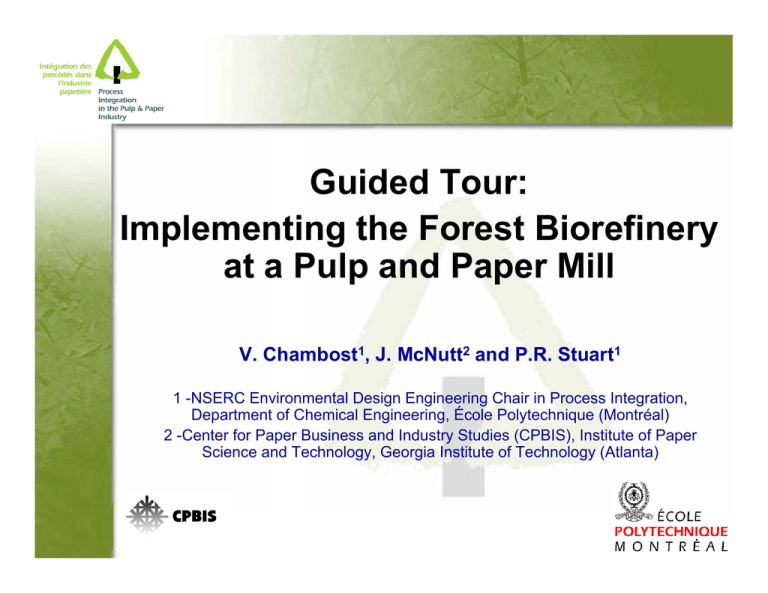
Guided Tour: Implementing the Forest Biorefinery at a Pulp and Paper Mill V. Chambost1, J. McNutt2 and P.R. Stuart1 1 -NSERC Environmental Design Engineering Chair in Process Integration, Department of Chemical Engineering, École Polytechnique (Montréal) 2 -Center for Paper Business and Industry Studies (CPBIS), Institute of Paper Science and Technology, Georgia Institute of Technology (Atlanta) Presentation Outline Types of Enterprise Transformation Biorefinery platform definition Product Portfolio and method for its determination Phased Approach for forest biorefinery implementation Identifying the Right Biorefinery Configuration is Complex… Key Questions to be Addressed Related to Implementing the FBR What are the key factors regarding biorefinery product selection, that will provide a sustained return over the short and long terms? What supply chain management changes are implicated for product delivery and the targeted new market(s)? Who are the best partner(s) for a winning business strategy? What biochemical, thermochemical and chemical biorefinery processes enable product diversification, while providing the targeted return on investment? How will the mill/company transformation to the forest biorefinery impact the day-to-day pulp and paper operations, at each step of implementation? Enterprise Transformation: Definitions 2 transformation concepts: Inside-out: • Transform the enterprise by changing processes within the existing organization, including changes in manufactured products Outside-in: • Core vision, mission and strategies are changed to create a new focus to outside markets that is sustainable, using new and integrated delivery techniques and with vastly improved bottom-line results ¾Transformation to the forest biorefinery implies both types of transformation Can Forestry Companies Adopt this Culture? Core business transformation, by product portfolio adjustments related to 204 Years of Innovation market evolution. 3 Maturity Maturity Cyclical adaptation to reinvent the business and transform the enterprise, while avoiding declining revenues. Maturity Growth Growth Birth Growth Birth Birth Chemistry, Energy Chemistry, Biology, Materials Science Explosives 1802 1830 1850 1900 1925 1945 1990 2000 2050 2090 Biorefinery opportunity for forestry industry 19 Sept 06 Presentation Objectives To demonstrate how forestry companies should consider a market-driven product selection while establishing their biorefinery strategies, and characterize the implied company transformation. Biorefinery Platform Definitions Co-products or wastes? Waste Chips Biomass Pulp and Paper Mill P&P Products Yield? Building Block Yield? Yield? Derivative Derivative Reducing Volumes, Flexible Throughputs… Increasing Process Complexity $$ ‘Product Portfolio’ $$$ Product Portfolio Definition Process Platform Biorefinery Product Portfolio structure Product Platform 1 A 2 B 3 C Product Families Market Segment … … … … … … … Considering Existing Pulp and Paper Product Portfolio Value Chains need to consider long term biorefinery sustainability: Unique supply chain is key for competitive position over the longer term Production flexibility (supply/demand) Margins stability and risk mitigation challenges must be systematically addressed while diversifying the product portfolio incrementally Product Portfolio for the Forest Biorefinery N RE L Ap Innovation h c a o pr Novel g Pe nn e r Ap proa ch Substitution CHALLENGE For product selection Technology Push Process-centric design Gre Substitution Market Pull Replacement Product-centric design Adaptation Inspired by Ref: M. Muffatto & M. Roveda, Product architecture and platforms: a conceptual framework Guided Tour: Implementing the Forest Biorefinery Objectives: Presenting a Methodology for determining the mill-based product portfolio, including building block chemicals and derivatives, while considering product/process design Presenting a Phased Approach for incrementally implement biorefinery activities while setting a biorefinery strategy Example based on Ethanol to Ethylene and Polyethylene value chain Proposed Methodology to drive the product design: Chambost, V., Eamer, B., Stuart, P., ‘Systematic Methodology’ PAPTAC 2007 Overall Product/Process Opportunities Outcome: Product Value Chain Opportunities by region and by priority Product/Process Details Analysis Business Plan & Biorefinery DecisionMaking Implementation Considerations Selecting the Most Promising Building Block Chemical Today! Cellulosic ethanol as the most promising building block? Large market – supply/demand structure Technology know-how is relatively well-developed Processing costs need to be lower compared to the conventional process Fierce volatility on the market… Ethanol Price Volatility Peak at ≈ $3/gal Source: Gulf Ethanol Corp In 6 months: ethanol prices dropped by more than 50% Price is not the challenge, price volatility and competition are How can we stabilize operating margins in a context of volatility and market uncertainty? Choosing ethanol as a building block for the biorefinery implementation? Benefit from increasing ethanol market - there will always be a demand – Reduce the impact of volatility on biorefinery activities by diversifying the ethanol product family 14th January <$1.25/gal Source: Gulf Ethanol Corp Building a Product Platform Market Considerations Greg Penner, market opportunity for biobased chemicals, 2007 Ethylene to polyethylene value chain in Canada: The largest petrochemical value chain in Canada (LLDPE – LDPE – HDPE) Sufficient ethylene availability for the polyethylene value chain on a national basis Opportunities Maintain the existing value chain: • Develop biomass-based green ethylene at lower cost basis than petroleum-based Benefit from the existing value chain: • Enter a well-established market • Existing Infrastructure - e.g. Nova invested in Flexi-Cracker technology Future challenges: Securing the feedstock costs: ‘a salient economic driver’ • 85% of the PE production cost is driven by ethylene cost (driven by natural gas and crude oil price) Regional imbalances to be secured: • Quebec and Ontario facing negative trade balance for LDPE Technology Considerations Technical Potential: Conversion of lignocellulosic biomass to ethanol: • • • No commercial scale operation yet Demonstration plants in place will lower technical risks First plants evaluated for scale-up, goal to reduce capital and operating costs of subsequent plants Sugarcane ethanol based polyethylene production in Brazil: • • JV Dow – Crystalsev: 350 000T/y of LLDPE Dowlex by 2011 Braskem activities: 120 to 200 000t/y of HDPE by 2009 Economic potential: Ethanol production cost will be a driver First-to-market will be critical to secure the green market segment for polyethylene Proposed Methodology to drive the product design: Chambost, V., Eamer, B., Stuart, P., ‘Systematic Methodology’ PAPTAC 2007 Overall Product/Process Opportunities Outcome: Product Value Chain Opportunities by region and by priority Product/Process Details Analysis Outcome: Information needed for business plan development Business Plan & Biorefinery DecisionMaking Outcome: Biorefinery Strategy & Go/No Go Decision Implementation Considerations Phased Approach for Implementing the Biorefinery Implementation: compete with all capital spending Phase I Lower Operating Costs: Replace fossil fuels at mill (natural gas, Bunker C), and/or Produce “building block” chemical Minimum risk technologies in Ma s ge n e all ch Compete internally for capital Phase II Increase Revenues: Exportable green energy, and/or Manufacture of derivatives Market development for new products Higher process complexity and technology risk Partners essential Select the most sustainable product platform and partner(s) Phase III Improve Margins: Knowledge-based manufacturing and production flexibility Business flow transformation Product development culture Off-shoring, Outsourcing, etc… Core business transformation SCM key to success Strategic Vision: Phase II must determine Phase I & III Phased Approach for Implementing the Biorefinery Implementation: compete with all capital spending Phase I Lower Operating Costs: Replace fossil fuels at mill (natural gas, Bunker C), and/or Produce “building block” chemical Minimum risk technologies Phase II Increase Revenues: Exportable green energy, and/or Manufacture of derivatives Market development for new products Higher process complexity and technology risk Partners essential Phase III Improve Margins: Knowledge-based manufacturing and production flexibility Business flow transformation Product development culture Off-shoring, Outsourcing, etc… Margins improve with Enterprise Transformation Strategic Vision: Phase II must determine Phase I & III Take-Away Messages Both inside-out and outside-in transformations are implied by the biorefinery product portfolio The definition of a biorefinery product portfolio is critical, and needs to consider both market and technical perspectives These product-centric analyses are followed by process design, partner identification, and other key considerations concerning supply chain changes With the overall strategy defined, transformation to the forest biorefinery is best achieved using a phased implementation Guided Tour: Implementing the Forest Biorefinery at a Pulp and Paper Mill Thank you!
